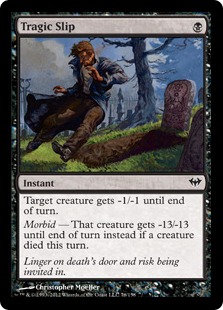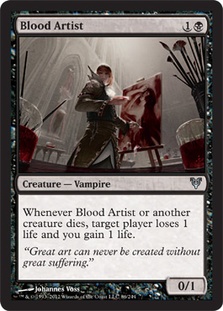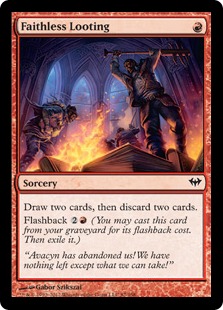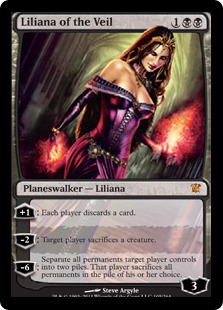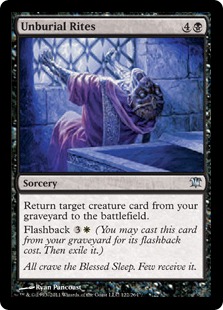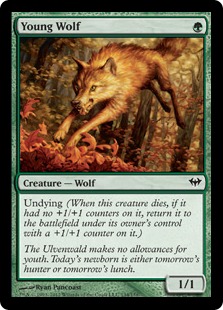Last week I mentioned that this past weekend would be huge for Standard. While I don’t know if my hypothesis that there were more people playing Standard than ever before was accurate, I do know that there is a ton of tournament results to process and that several awesome new decks emerged. I still haven’t seen the results of every country, but I’ve looked at a good number. My goal today is to highlight some of the more interesting decks that succeeded last weekend and discuss why I think they did well and what the future might hold for them.
To start with, I was at the StarCityGames.com Invitational and played The Aristocrats: Act 2, which I consider the breakout new deck of the weekend in Atlanta. Brad Nelson has been doing a lot of good work designing Standard decks, and his update of my The Aristocrats deck takes the deck in some really powerful new directions. Brad was far from the only person playing the deck last weekend, but he was the most successful, which is fitting since he did the most work on it.
Brad played:
Creatures (24)
- 4 Skirsdag High Priest
- 4 Doomed Traveler
- 4 Falkenrath Aristocrat
- 4 Blood Artist
- 4 Cartel Aristocrat
- 4 Boros Reckoner
Planeswalkers (1)
Lands (24)
Spells (11)

The biggest change I would make to his deck is cutting Orzhov Guildgate for Cavern of Souls or Vault of the Archangel. It feels weird to not play Vault of the Archangel in a token deck because it can be so good, but it doesn’t actually get activated that much and I can see just wanting to cast your spells. I know that’s the direction I went in G/B/W Reanimator, but if that’s my goal, I’d rather have a Cavern of Souls than Orzhov Guildgate.
This deck has some really outstanding matchups.
It has the original The Aristocrats largely dominated since it has four Tragic Slips, the best removal spell in the mirror, and four Blood Artist, which is absolutely the most important card in the matchup. If this deck plays against the aggressive take on The Aristocrats that cuts Boros Reckoner to focus on Champion of the Parish aggression, Blasphemous Act also becomes nearly unbeatable. It’s difficult to imagine losing a match with this deck against the old popular configurations of The Aristocrats.
It’s similarly outstanding against slower midrange creature decks without a lot of removal, like Prime Speaker Bant, which might see a resurgence after Matt Sperling PTQ win last weekend. That kind of deck has a lot of trouble with Skirsdag High Priest, Falkenrath Aristocrat, and the Blasphemous Act combos and doesn’t kill you fast enough to stop one of those things from taking over a game.
Most importantly, G/B/W Reanimator is slow enough to loosely fall into that model, and Act 2 has a great matchup against it. To me, this is the biggest reason to play the deck.
The matchup against Esper Control is also good because you have a lot cards that they have a really hard time beating like Falkenrath Aristocrat; Sorin, Lord of Innistrad; and Obzedat, Ghost Council—with Duress to set them up after sideboarding. I’ve won a truly shocking number of game 1s by Blasphemous Acting my Boros Reckoner against them, which is not how I would have expected the matchup to play out.
Unfortunately, I think this incarnation of The Aristocrats is still largely a metagame call, as it does have some substantial weaknesses.
Its matchup against Naya Blitz isn’t great, and Jund Aggro is even worse, especially if their draw leads to them attacking entirely with three-toughness creatures so that your Doomed Travelers and Cartel Aristocrats can’t shut down their attackers. If you have a very good draw with Skirsdag High Priest or Boros Reckoner or Blasphemous Act, you can usually win, but it’s easy to stumble or draw the wrong cards and lose. This isn’t a huge strike against the deck because the matchup really isn’t that lopsided—I just think it’s close. I might actually be happy to play against Naya Blitz, but I’d definitely rather avoid Jund Aggro.
The deck I’d really want to avoid playing against is Jund. Bonfire of the Damned and Thundermaw Hellkite make the plan to use Sorin and Lingering Souls pretty worthless, and the fact that they kill each of your creatures as you play them makes it hard to get much value out of Blood Artist or cast Blasphemous Act. Huntmaster of the Fells, Olivia Voldaren, and Thundermaw Hellkite are all very good against you. I have a really hard time figuring out a way to sideboard my deck or sculpt a game that would give me much of a chance.
The biggest card I’m missing in the matchup from the traditional The Aristocrats is Zealous Conscripts, so it’s possible that the matchup could be helped substantially by adding some number of Zealous Conscripts to the sideboard, which I would do if you think the metagame is right for Act 2 except that you expect some Jund. I would probably look at Tormod’s Crypt as the card to cut since Zealous Conscripts can come in against Reanimator to good effect anyway.
The next deck I want to talk about is Finnish champion Sami Haggkvist’s take on the same colors. Sami’s deck is noteworthy because he won two tournaments in the same weekend—a WMCQ and a PTQ—with it, and it’s an unusual (but not completely unknown) Standard deck choice.
Creatures (13)
- 2 Olivia Voldaren
- 2 Restoration Angel
- 2 Thundermaw Hellkite
- 1 Angel of Serenity
- 2 Obzedat, Ghost Council
- 4 Boros Reckoner
Planeswalkers (2)
Lands (26)
Spells (19)

I wrote about this deck for Daily Decks on Daily MTG here, but that’s for a slightly different target audience. Here I’d like to look at the deck a little more critically and consider its implications for the metagame.
Sami’s using Faithless Looting and Liliana of the Veil to set up Unburial Rites, but outside of his one Angel of Serenity, he’s saving at least one mana on that play. This means his goal is to get value from Faithless Looting, not Unburial Rites (which makes sense given that he’s playing four Faithless Lootings and only two Unburial Rites). This is the much less ambitious card to get value off of, which is to say that this deck is trying to operate entirely as a fair deck. He doesn’t want to rely on combos or drawing particular cards to work together. This is a “good stuff” deck that is looking to play a good, clean, interactive game of Magic.
The way he’s chosen to do that potentially leaves him open to attack by unfair strategies, but he’s overloaded on Appetite for Brains, Slaughter Games, and even included Purify the Grave to keep Reanimator fair against him. Once he’s done that, he very well set up to beat other decks on the fair axis. He has a lot of the same cards as Jund, but while he’s missing Thragtusk, he’s set up his creatures to all perform excellently against the card. Ironically, a way to understand this deck is that he’s forcing everyone to play “Thragtusk Magic” and then winning the Thragtusk mirror by turning them into a liability and not having his own.
The big question to me is whether he hurts himself too much against aggressive decks with this omission, but Boros Reckoner and Obzedat, Ghost Council definitely go a long way there. Still, I can definitely imagine matchups where he’d really want some more Gloom Surgeons.
Another exciting new deck came out of Brazil, winning the WMCQ there, which had over 250 people. That’s not a huge tournament by American standards, but it’s enough to mean it’s worth giving serious respect to someone who can win it with a deck that’s actually radically new, which I think (unless I’ve missed some shocking Magic Online results) you’ll have to agree this is:
Creatures (25)
- 2 Snapcaster Mage
- 1 Evil Twin
- 4 Strangleroot Geist
- 3 Young Wolf
- 1 Wolfir Avenger
- 4 Dreg Mangler
- 4 Experiment One
- 2 Zameck Guildmage
- 4 Duskmantle Seer
Lands (23)
Spells (12)
Sideboard

Davi, you had me at Young Wolf. I’m in love.
Seriously, I haven’t played it yet, but this deck looks awesome. Turn 1 Experiment One, turn 2 Young Wolf, Rapid Hybridization it—build your own Burning-Tree Emissary + Flinthoof Boar! This deck looks outstanding against Reanimator because of the counterspells, Deathrite Shamans, and, most importantly, Evil Twins and Duskmantle Seers; good against control because its creatures are so resilient; and good against aggro because the undying creatures are so good at blocking.
I haven’t played it, so I don’t know which of these is actually weaker than I want it to be on paper, but this is a seriously exciting deck for someone like me.
I think this deck is pretty well put together for what it is, but decks have a way of getting cleaned up when the public gets their hands on them. I wouldn’t be surprised if the Wolfir Avenger becomes a Young Wolf just to make the numbers cleaner, and I worry about the Snapcaster Mages potentially not having enough targets (nine isn’t too bad for two Snapcasters though).
Either way, I love both the fact that someone was successful with something this new and the look of the actual deck itself. I hope the community tries it out, and I hope it can hold up.
Those are the highlights. Let me wrap up by listing the other winners that I know of:
Italy: WMCQ – Emanuele Giusti, Jund; PTQ – Marco Cammilluzi, G/B/W Reanimator (with 3 MD Somberwald Sage)
Netherlands: WMCQ – Jasper Boelens, The Aristocrats: Act 2
Ireland: WMCQ – David Tuite, 23-land Esper
Sweden: WMCQ – Joakim Atkins, Jund
USA: WMCQ – Jason Gulevich, Naya Blitz; PTQ – Matt Sperling, Prime Speaker Bant
Costa Rica: WMCQ – Fernando Solorzano, The Aristocrats: Act 2
Russia: WMCQ – Alexandr Shedyakov, R/G Aggro
Denmark: WMCQ – Naya Blitz (Sent to me by Thomas Enevoldsen, but I don’t know if he was the winner.)
Colombia: WMCQ – Vladimir Mayoral, Prime Speaker Bant (with one Sleep that he used to win the finals)
Dominican Republic: WMCQ – Jayme Castellanos, G/B/W Reanimator
That’s not a ton of data, but it’s worth noting that The Aristocrats: Act 2 won in two of those countries despite the fact that the deck had just debuted (a week earlier Jacob Van Lunen won a PTQ with it, but that wasn’t very widely publicized), so many players probably didn’t know about it. Other than that, it seems very clear to me that Naya Blitz and G/B/W Reanimator are the two “best decks” in the format. G/B/W Reanimator’s 1st and 2nd place finish in the Standard Open in Atlanta last weekend certainly further demonstrates just how well the deck can stand up to hate, even with decks like Act 2 coming up that are designed to beat it (and, in fact, one of them beat Brad Nelson playing Act 2 on his way to the finals).
All in all, I think this is a very good Standard format that’s seen success with an extremely wide variety of strategies and continuous new developments. It also offers a few consistent boogeymen for people who want to know what they have to try to beat and want to be the hero or people who just want to play the best deck.
Next up, we get to start thinking about what spoiled cards from Dragon’s Maze will do to shake this up.
Thanks for reading,
@samuelhblack on Twitter

